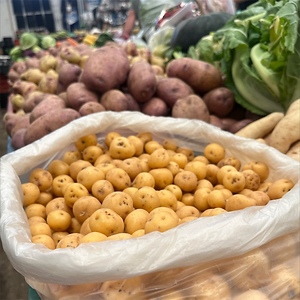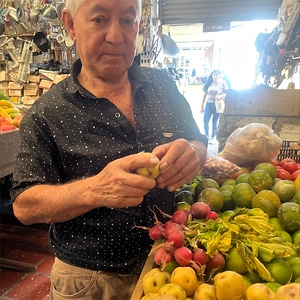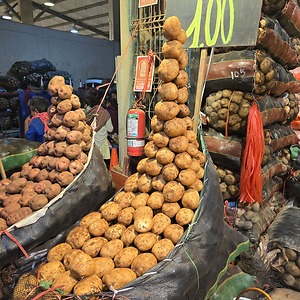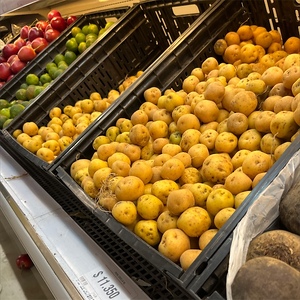


Amarilis Potatoes
Estimated Inventory, lb : 0
Description/Taste
Amarilis potatoes are typically round to oval in shape with a slightly crooked, bumpy exterior, but they may also be found in an elongated to cylindrical shape depending on cultivation habits. The skin is semi-rough, covered in marks, nicks, and a few deep-set eyes, and ranges in color from dark brown to light tan. Underneath the surface of the thin skin, the flesh is firm, dense, and waxy with a golden appearance. When cooked, Amarilis potatoes are smooth and tender with an earthy, mildly sweet flavor.
Seasons/Availability
Amarilis potatoes are available year-round.
Current Facts
Amarilis potatoes, botanically classified as Solanum tuberosum, are edible underground tubers that grow from a small leafy plant and belong to the Solanaceae or nightshade family along with eggplant and tomatoes. Created by the International Potato Center also known as CIP, in Lima, Peru, Amarilis potatoes were developed to have resistance to late blight, which is a disease that can quickly wipe out potato plants and was the same disease that caused the Irish potato famine in the 19th century. With its introduction, Amarilis potatoes have helped protect Peru’s potato cultivation and have prevented crops from being destroyed by blight, increasing revenue and stability within the business. Amarilis potatoes are still cultivated on a small scale compared to other blight resistant varieties such as the canchan, but it is slowly increasing in popularity in the culinary market and is favored for its short growing cycle, prolific nature, early season arrival, and versatility in cooked applications.
Nutritional Value
Amarilis potatoes contain vitamin C, potassium, calcium, fiber, and some vitamin B6.
Applications
Amarilis potatoes can be used in a wide variety of cooked applications such as steaming, baking, frying, roasting, and boiling. The tuber’s slightly waxy texture allows it to hold its shape well when cooked and can be boiled and stirred into potato salads, mashed and served with meat and shrimp, or scalloped and paired with stuffed peppers. In addition to everyday preparations, Amarilis potatoes are commonly used in the traditional Peruvian dish known as ajiaco, which is a creamy potato soup. The tubers are also used in causa, a layered dish of mashed potatoes encasing avocado, fish, or chicken salad, in salchipapas, a street food of sausages and French fries topped with a sauce, and in lomo saltado, which is one of the most well-known Peruvian dishes where French fries are mixed with a steak stir-fry consisting of tomatoes, parsley, soy sauce, and rice. Amarilis potatoes pair well with herbs such as oregano, cilantro, and thyme, spices such as cumin, coriander, and chile powder, aromatics including garlic, yellow onion, and red onion, tomatoes, beef, poultry, fish, eggs, and cheeses such as provolone or gruyere. The tubers will keep for 3-5 weeks when stored in a cool, dry, and dark place.
Ethnic/Cultural Info
Amarilis potatoes are regarded by many experts to be one of two of the International Potato Center’s most successful varieties. Blight is the most destructive disease in the potato industry and is believed to cause over ten billion dollars in profit loss throughout the industry worldwide. To help eradicate the disease, the International Potato Center in Peru has been focusing on developing varieties that are highly resistant to blight but are also marketable for culinary use. Amarilis, along with the variety canchan, were released from CIP and became widely successful in select regions of Peru, saving the farmers money and reducing the number of crops that are lost each season. Amarilis and Canchan currently account for more than thirty percent of the total potato cultivation in Peru.
Geography/History
Amarilis potatoes were created by the International Potato Center in Lima, Peru in the early 1900s. Bred with the intention to develop a variety resistant to late blight, Amarilis potatoes were released in 1993 and received positive feedback by farmers worldwide for its resistance to disease. Today Amarilis potatoes are predominately grown in Peru and are sold through local farms at fresh markets. They may also be exported on a small scale to select markets worldwide.
Recipe Ideas
Recipes that include Amarilis Potatoes. One












